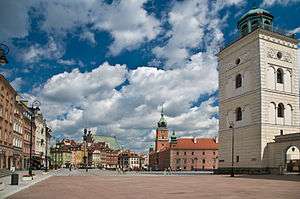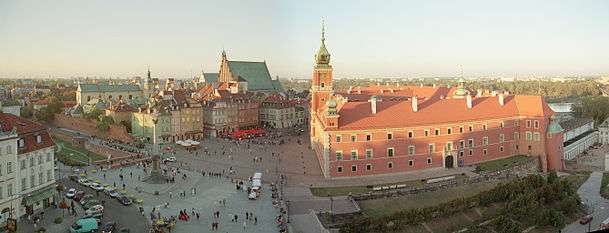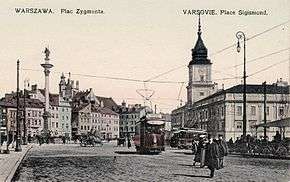Castle Square, Warsaw
| Plac Zamkowy | |
 | |
| Type | Square |
|---|---|
| Maintained by | Warsaw City Council |
| Location | Śródmieście, Warsaw, Poland |
| Coordinates | 52°14′51″N 21°0′49″E / 52.24750°N 21.01361°ECoordinates: 52°14′51″N 21°0′49″E / 52.24750°N 21.01361°E |
| South | Royal Road |


Warsaw's Castle Square (Polish: plac Zamkowy w Warszawie) is a historic square in front of the Royal Castle – the former official residence of Polish monarchs – located in Warsaw, Poland. It is a popular meeting place for tourists and locals. The Square (in a more or less triangular shape) features the landmark Sigismund's Column to the south-west, and is surrounded by historic townhouses. It marks the beginning of the bustling Royal Route extending to the south.
History
The column commemorating King Sigismund III Vasa (a work by Clemente Molli, erected in 1644) is the oldest and one of the symbolic monuments of the city. On the east side of the square stands the Royal Castle reconstructed after the devastation of World War II. It was formerly the residence of the dukes of Mazovia, and then of the Polish kings and grand dukes of Lithuania from the 16th to 18th centuries. The Nazis bombed and blew it up by during World War II. In 1949 the square was connected by an escalator to the newly formed Route W-Z (East-West Route), which runs under Castle Square though a tunnel; and the viaduct (leading to the Silesian-Dąbrowski Bridge) was built in the place of viaduct Pancer, destroyed during World War II. In 1907 the viaduct was modernized to handle electric trams that went over there less than a year later.
This square has witnessed many dramatic scenes in Polish history. Patriotic demonstrations took place there during the period before the outbreak of the January Uprising of 1863. On February 27, 1861, Russian bullets killed five people. On April 8, 1861 five rota of infantry and two troops of Russian cavalry (about 1,300 people) led by General Stepan Aleksandrovich Khrulyov carried out a bloody massacre of civilians, resulting in the deaths of more than 100 people.[1]
During martial law the square became the scene of the particularly brutal riot, with ZOMO police rushing through demonstrations on May 3, 1982.
Events
The square is a hub for tourists and locals, who gather to watch street entertainers, participate in rallies, watch concerts and even engage in breakdancing. In 1997, at the Castle Square, U.S. President Bill Clinton gave a speech welcoming Poland to membership in NATO.[2]
Castle Square featured the United Buddy Bears exhibition in summer 2008 - an array of 140 two metre-high sculptures, each designed by a different artist, touring the world as a symbol of cultural understanding, tolerance and mutual trust.[3] According to official information, more than 1.5 million visitors were counted.
See also
Notes
- ↑ Kieniewicz, Stefan (1983). Warszawa w powstaniu styczniowym (in Polish). ISBN 83-01-03652-4.
- ↑ "Archiwum działalności Prezydenta RP w latach 1997-2005". www.prezydent.pl (in Polish). 1998-01-15. Retrieved 2008-07-01.
- ↑ "United Buddy Bears in Warsaw". www.buddy-baer.com. 1998-01-15. Retrieved 2010-01-25.
External links
| Wikimedia Commons has media related to Castle Square in Warsaw. |